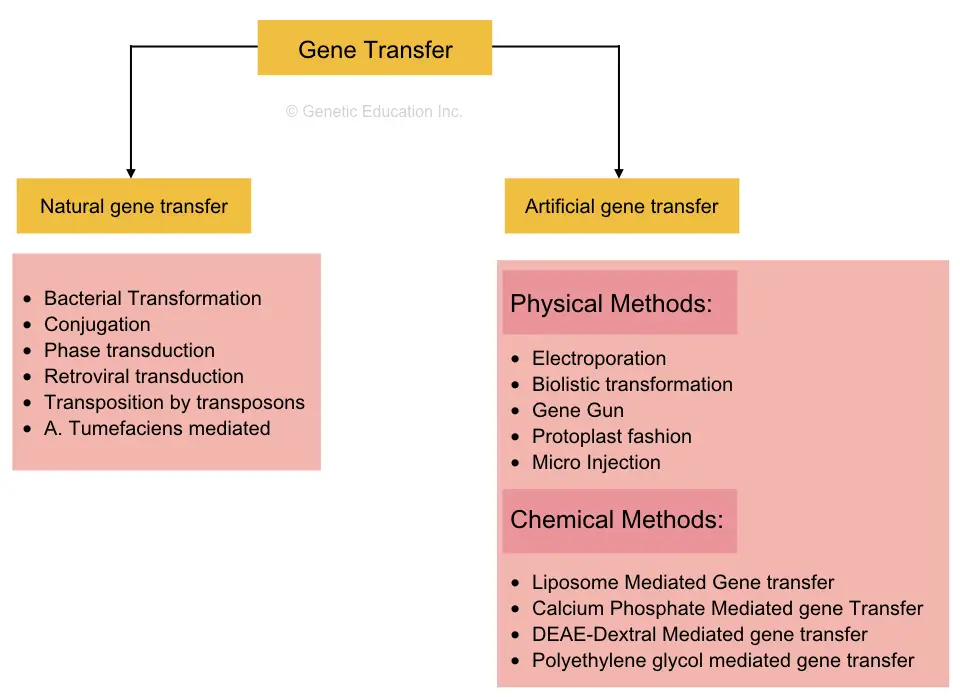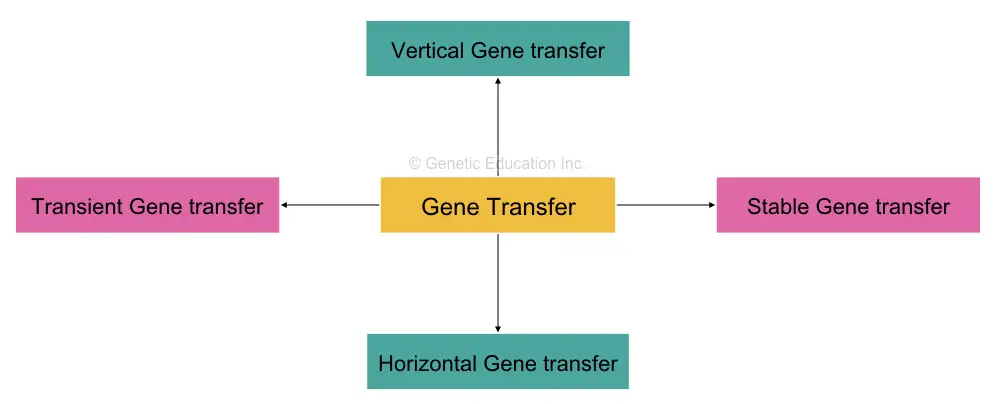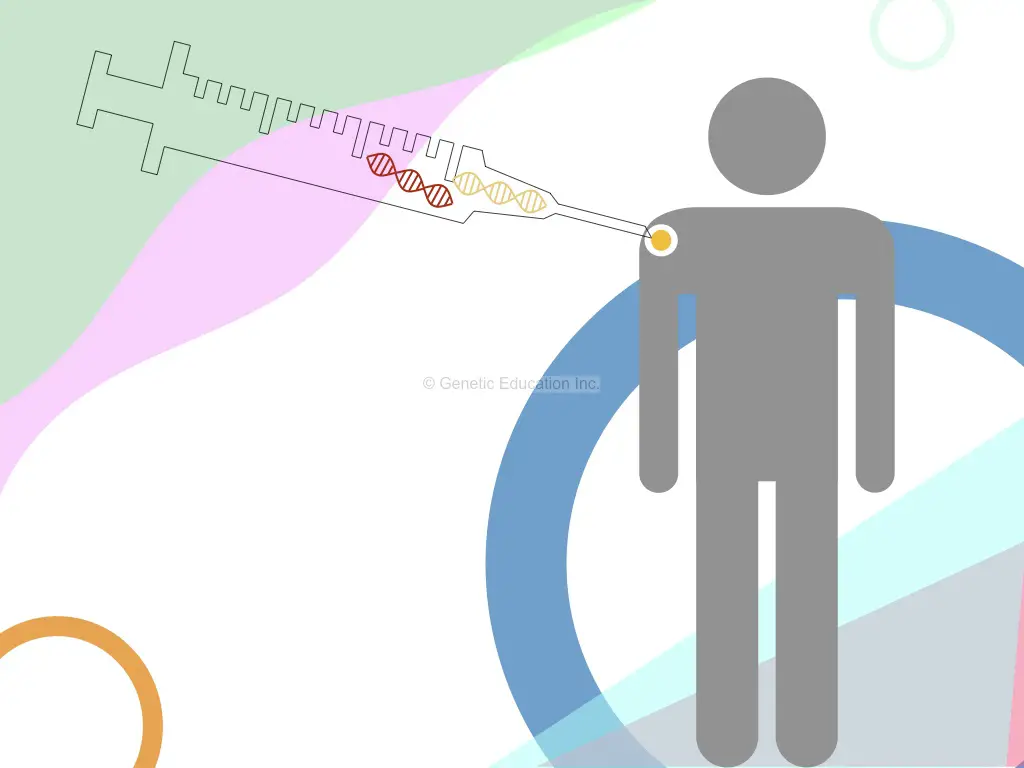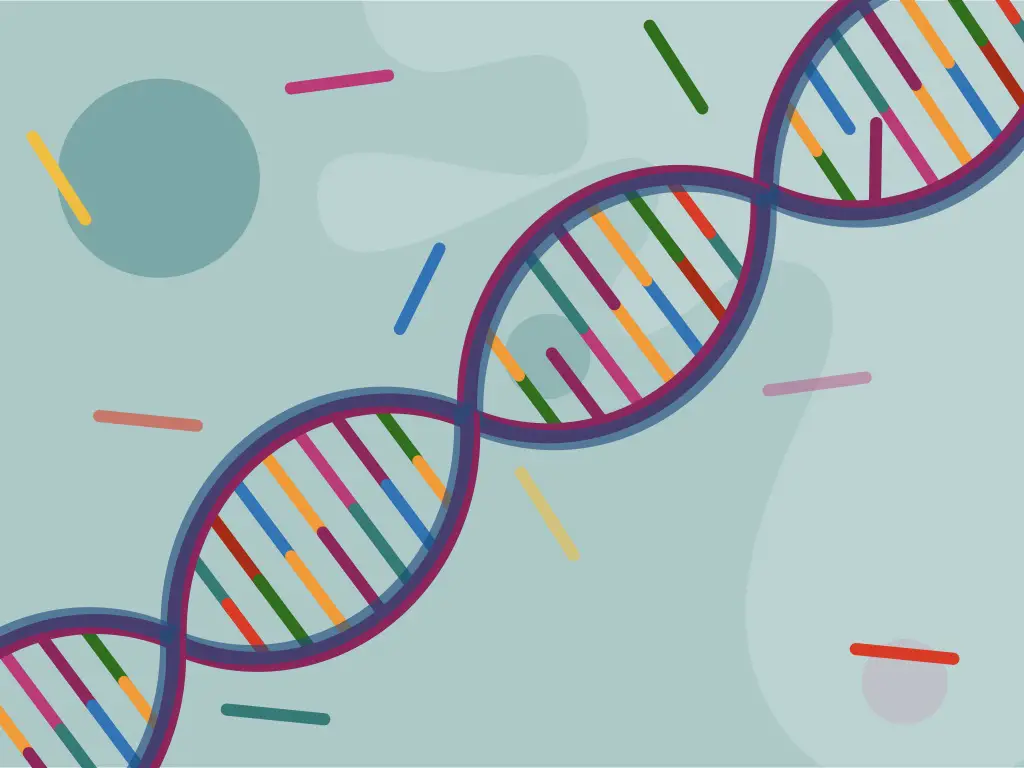Gene transfer is a technique to transfer a gene efficiently and stably into another cell or organism to alter its phenotype.
Gene transfer, genetic engineering and rDNA are now known to us, we are using them to perform different genetic and genomics experiments. Scientists are using those techniques to alter the genome of an organism.
But why are we altering the genome of some organisms? Researchers are doing so to make economically important plant species and microorganisms, to treat disease, to monitor the prognosis and therapy treatment of cancer, etc. Although the entire gene modification technology is not ready at least for now.
Gene transfer is a natural mechanism that occurs in different organisms and scientists also use it to make genetically modified organisms.
Vectors, plasmids, viruses and some physical techniques are used as a vehicle to transfer genes.
The objective of artificial gene transfer is to change the phenotype of an organism by changing its genotype or gene expression.
Related article: genotype vs phenotype.
In the present article, we are discussing different techniques of natural as well as artificial gene transfer, a brief overview of the whole process and its applications.
Key Topics:
What is gene transfer?
Definition:
A genetic engineering technique to transfer genes using vectors from one organism to another or from one cell to another in order to treat disease, construct GMO and economically important organisms are known as gene transfer.
A short history:
The first evidence of gene transfer was reported in bacteria by Frederick Griffith in 1928. He had named it a transformation. In 1944, Avery had demonstrated that the material transfer between bacteria during transformation is the nucleic acid (DNA) which was later validated by Hershey and Chase in 1952.
Although the exogenous gene transfer in a eukaryotic cell (in vitro) was demonstrated by Rogers in 1970.
Types of gene transfer
Usually, the gene transfer techniques used in various applications can be categorized into two broader categories.
- Natural methods of gene transfer
- Artificial methods of gene transfer

The natural mode of gene transfer: In this technique natural agents like live cells, bacteria, other DNA molecules and viruses are used to transmit genes. Some of them are:
- Bacterial transformation
- Conjugation
- Phage transduction
- Retroviral transduction
- Transposition
- Agrobacterium tumefaciens mediated gene transfer
The artificial method of gene transfer: In this technique, an exogenous gene is transmitted to another cell or organism using artificial means either physical or chemical agents. Some of the common artificial techniques are:
Physical methods
- Electroporation
- Biolistics transformation
- Gene gun
- Protoplast fusion
- Microinjection
Chemical methods
- Liposome mediated gene transfer
- Calcium phosphate mediated gene transfer
- DEAE- Dextran mediated gene transfer
- Gene transfer using polyethylene glycol
Yet another classification of gene transfer is based on which organism it affects. It can be categorized into horizontal gene transfer and vertical gene transfer.
Horizontal gene transfer vs vertical gene transfer:
When gene transfer occurs between two unrelated individuals or organisms, this type of gene transfer is known as horizontal gene transfer. It is also called the lateral gene transfer method.
Usually, it is commonly observed between prokaryotic and eukaryotic cells. The origin of antibiotic resistance in bacteria is the classic example of the horizontal gene transfer by natural means.
On the other side in the vertical method of gene transfer, the genes are transmitted from parents to their offspring.
This means the transfer of genetic material or genes from one cell to another or one organism to another related organism is known as the vertical mode of gene transfer. Several examples of horizontal gene transfer are:
Transformation: Alteration in a gene by uptaking genetic material from unrelated organisms is known as transformation. It is used in transformation experiments to transmit genes in bacteria to infect a host.
Transduction: Transfer of genetic material from one bacterium to another by the virus or phase is known as transduction.
Conjugation: The gene transfer of one cell to another using the bacterial plasmid from donor to recipient cell is known as conjugation.
Transposable elements: The transposons or transposable elements are the mobile genetic sequences that can carry a gene or DNA and can transfer it to other unrelated cells.
Cervical cancer caused by HPV is an example of horizontal gene transfer in which the infected cell transmits the genetic material to another cell and spreads cancer.
On the other side,
The gene transfer from one related cell to another or parental organisms to their progenies is known as a vertical mode of gene transfer.
The process of reproduction or the sexual mode of reproduction is a type of vertical mode of gene transfer.
Crossbreeding in plants is the most common example of vertical gene transfer used by scientists for a long time. These two plants are sexually reproduced or crossed to produce a superior quality plant species.
Further to this, the meiosis and mitosis cell division process is a way of vertical gene transfer in which genetic material is inherited from one identical cell to another.
Infection of HIV from mother to child is an example of it. Here the infected patient or cell inherited the genetic material of HIV along with their own to their offspring. Resultantly, the progeny of the baby got infected by HIV.
Transient vs stable gene transfer or transfection:
In the transient type of gene transfer, the foreign genetic material is never incorporated into the host genome and thus can’t be inherited into offspring.
On the other side, in the stable gene transfer, the gene or foreign DNA inserts into the host genome and transmits into the offspring.
The transient gene transfer is performed to produce a temporary high level of gene expression and thus it is limited to somatic cells.
While in the stable gene transfer, once the gene is incorporated into the host genome it may express normally, transmit to offspring and express normally in them too.
It is usually performed on germ cells.

Artificial Gene transfer techniques:
Physical Gene transfer methods:
Electroporation, biolistics transformation, gene gun, protoplast fusion and microinjection are some common physical gene transfer techniques used often in genetic engineering experiments. We are discussing every method comprehensively here.
Electroporation:
The electroporation technique is one of the commonest and successful methods used so far by scientists. In this method, the gene of interest or the DNA is transferred into the target cell under the influence of an electrical pulse.
Under the pulse electric current, pores are created in the cell wall or the plasma membrane of a cell which allows DNA intake.
Once the electrical current is discharged, the pores are closed. The electroporation method is used for both stable and transient gene expression.

We have covered the entire article on these topics, You can read it here: Electroporation- a modern gene transfer technique.
Biolistic transformation
The biolistic transformation is also known as a biolistic particle delivery system. In this method, a gene of interest coated with heavy metal ions is inserted into the target cell by mechanical force.
Gene gun is a common name used for it. Molecules like DNA, RNA or protein can be inserted into a cell directly.
Protoplast fusion:
A cell without a cell wall or cell membrane is known as a protoplast. The protoplast fusion method is also used in the tissue culture methods in which two protoplasts of somatic cells are fused to get a hybrid protoplast of two different cells. It is commonly practiced in plant research to produce genetically altered plant species through their protoplast fusion.
Microinjection:
The microinjection method facilitates direct nuclear delivery of exogenous DNA. Using a fine needle, or injection, a DNA or gene is directly injected into the target cell nucleus without disrupting the endogenous pathway.
The microinjection gene transfer technique is practiced to inject genes directly into oocytes, eggs and embryos.
Chemical methods of gene transfer:
Liposome-mediated gene transfer, calcium phosphate mediated gene transfer, DEAE-Dextran mediated gene transfer and polyethylene glycol mediated gene transfer are common chemical methods used in transformation experiments.
Before discussing various chemical methods to transfer a gene, we should have to understand how chemical-mediated gene transfer techniques actually work! Because the whole mechanism is different.
Here the naked DNA is used to fuse the complex with a chemical agent (and therefore it is also known as naked-DNA mediated gene transfer). The chemical and DNA complex either interact with the cell wall or membrane or is processed through endocytosis. Once it enters into the cell cytoplasm, the DNA is released from the chemical agent and incorporated into the genome.
In comparison with physical gene transfer techniques, the chemical method is slightly less effective, though.
Liposome mediated gene transfer:
Among all chemical methods, liposome-mediated gene transfer or lipofection is most effective and used widely. The liposome is a phospholipid vesicle that inserts DNA once it interacts with the target cell.
It is a hydrophobic vesicle that surrounds the naked DNA and interacts with the cell wall or membrane. It inserts DNA into the cell cytoplasm. Although the method of making the liposome and incorporating DNA into it is tedious, time-consuming and labor-intensive.
Transfection with DEAE-dextran:
The DEAE-dextran is the polycationic carbohydrate soluble complex that makes aggregate or complex with the DNA. The idea is to make a net charge of the complex positive-charged so that it can interact with the negative charge of the cell wall.
It is often employed before the discovery of electrophoration.
Calcium phosphate transfection:
Yet another reliable chemical method of gene transfer is the calcium phosphate technique in which the DNA eluted in phosphate is mixed with the solution of calcium chloride and allows it to co-precipitate.
When mixed with the target cell population, some complex DNA and calcium phosphate precipitate when uptaken by the cells through the process of endocytosis and our DNA is inserted in the target cell.
The technique is simple, cost-effective, reliable than other methods and can transfect cells growing into the monolayer.
Note that it was the first method used to transfect the animal cells.
Virus mediated gene transfer:
The virus is the carrier of genetic material whose effort can help to transfer DNA in a target cell. Viruses are one of the most effective genes transfer vehicles.
Adenovirus, Adeno-associated virus, HIV, lentivirus and other retroviruses can be used for gene transfer. Although it can infect the host organism.
We have discussed different viruses and their DNA transfer capacity in our previous article. Read it here: Gene Therapy: Types, Vectors [Viral and Non-Viral], Process, Applications and Limitations.
Process of gene transfer:
The steps in the process of gene transfer are similar to other genetic engineering experiments. Common steps of the gene transfer method are:
- Isolation of gene of interest
- Selection of plasmid
- Restriction digestion of DNA
- Insertion of DNA into plasmid
- Selection of gene transfer technique
- Insertion of rRNA or altered plasmid into the target cell
- Cell culture
- Injection to the target organism
Let us briefly understand the process,
In the very first step, the organism and the gene of interest we wish to study and insert into the recipient organism are selected and studied.
Soon after, the appropriate vector or plasmid is selected which will insert our DNA. The plasmid must have promoter, enhancer, antibiotic resistance and restriction digestion gene sequences in it.
After that, the DNA is digested using the restriction endonuclease and ligated into the plasmid.
The method of gene transfer is selected and the altered plasmid, now known as the recombinant DNA is transferred into the host cell.
The altered cells are grown into the culture media, under aseptic conditions.

Note that this is the briefing of the entire process, steps and methods may vary also there are so many substeps and preparation steps that we haven’t discussed.
If you are interested in how the genetic transformation experiment is performed, you can read this article. It will really help you: what is genetic engineering?
Importance of gene transfer:
Why are we doing gene transfer? The answer is to create a variation or to produce a new phenotype that is useful, beneficial and important for us.
We have been using gene transfer techniques for so many years. In ancient times, crossing two different plants was common.
Inbreeding and crossbreeding were used to make various abiotic and biotic resistant plant species.
Even, bacteria follow the natural mechanism of gene transfer to surviving in harsh conditions. Gene transfer was not new to use, perhaps but a substantial improvement in techniques was done in the mid 19s.
In the present time, the gene transfer techniques that we have are efficient enough and accurate.
We are using gene transfer techniques to modify organisms’ genomes, especially the plant genome. To create various genetically modified plant species.
GM plant species are created to fight against biotic and abiotic stress, increase the nutrient values, decrease the cost and make it available for all.
Furthermore, genetically modified organisms are constructed to produce proteins, therapeutics, drugs and other important biomolecules.
The gene transfer technique is further practiced to cure disease and treat patients.
Conclusion:
Genes transfer techniques such as horizontal or vertical is performed to fulfill one global objective that is to create variations. The purpose of this is to make an organism adaptive in the present environment.
Nonetheless, artificial gene transfer is performed to benefit us only. Prior ethical consent must be taken before performing any genetic engineering experiments.
Sources:
Burmeister AR. Horizontal Gene Transfer. Evol Med Public Health. 2015;2015(1):193-194. Published 2015 Jul 29. doi:10.1093/emph/eov018.
National Research Council (US) Committee on a National Strategy for Biotechnology in Agriculture. Agricultural Biotechnology: Strategies for National Competitiveness. Washington (DC): National Academies Press (US); 1987. Appendix, Gene Transfer Methods Applicable to Agricultural Organisms. Available from: https://www.ncbi.nlm.nih.gov/books/NBK217998/.


